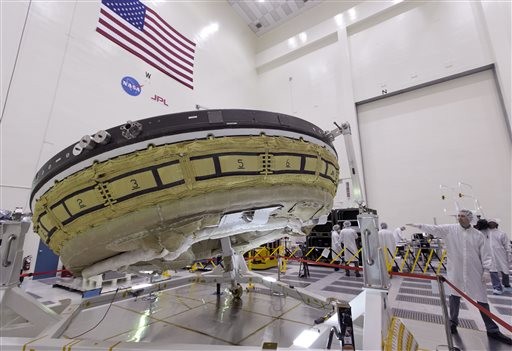NASA Mars 'saucer' test A-OK despite bad chute
| dweisman | | Aug 09, 2014 05:37 PM EDT |
(Photo : NASA) )
NASA engineers tested a vehicle designed to land astronauts on Mars with mixed results, but nonetheless insisted Friday it was a success.
A parachute fell apart while being tested at Pasadena's Jet Propulsion Laboratory for use in the Low-Density Supersonic Deceleration project. It disintegrated almost immediately after being employed. NASA officials termed the incident a learning experience.
Like Us on Facebook
Findings from six weeks of module testing for a flying saucer-type craft were disclosed during a Friday news conference at the Pasadena facility. High-altitude testing for the mission to Mars is estimated to have cost USD$150 million. It's all designed to transport humans to Mars and back.
Testing in the last few weeks went well because engineers achieved major goals, namely getting the vehicle shaped like a flying saucer up to 190,000 feet above Earth in test conditions resembling those on Mars while operating at as much as four times the speed of sound. Scientists said the saucer handled the speed and altitude with aplomb.
While the test in the sky went swimmingly, problems occurred as the vehicle simulated a fall back to Earth. It has a parachute designed to work like a puffer fish, deploying expanding chutes to slow down the craft through atmospheric pull. The craft has to slow quickly and safely from its Mach 4.3 speed to get to the Mars surface without crashing
Project managers said this was the first of a scheduled three tests for the vehicle. it achieved most of what engineers wanted to prove. Two more tests are planned for 2014 as engineers try to determine how to use the parachute without it tangling and tearing as it did during the test. The last few weeks of testing showed there was more work to be done in that regard, NASA officials said.
The proposed parachute is humongous and delicate at the same time. It's 200 pounds of Kevlar material that must be used under extreme conditions at 2,500 miles per hour n space. When inflated, the chute is the size of a small warehouse, engineers said, which put a strain on the material.
TagsNASA, Mars, Science, space exploration, technology
©2015 Chinatopix All rights reserved. Do not reproduce without permission
EDITOR'S PICKS
-

Did the Trump administration just announce plans for a trade war with ‘hostile’ China and Russia?
-

US Senate passes Taiwan travel bill slammed by China
-

As Yan Sihong’s family grieves, here are other Chinese students who went missing abroad. Some have never been found
-

Beijing blasts Western critics who ‘smear China’ with the term sharp power
-

China Envoy Seeks to Defuse Tensions With U.S. as a Trade War Brews
-

Singapore's Deputy PM Provides Bitcoin Vote of Confidence Amid China's Blanket Bans
-

China warns investors over risks in overseas virtual currency trading
-

Chinese government most trustworthy: survey
-

Kashima Antlers On Course For Back-To-Back Titles
MOST POPULAR
LATEST NEWS
Zhou Yongkang: China's Former Security Chief Sentenced to Life in Prison

China's former Chief of the Ministry of Public Security, Zhou Yongkang, has been given a life sentence after he was found guilty of abusing his office, bribery and deliberately ... Full Article
TRENDING STORY

China Pork Prices Expected to Stabilize As The Supplies Recover

Elephone P9000 Smartphone is now on Sale on Amazon India

There's a Big Chance Cliffhangers Won't Still Be Resolved When Grey's Anatomy Season 13 Returns

Supreme Court Ruled on Samsung vs Apple Dispute for Patent Infringement

Microsoft Surface Pro 5 Rumors and Release Date: What is the Latest?










